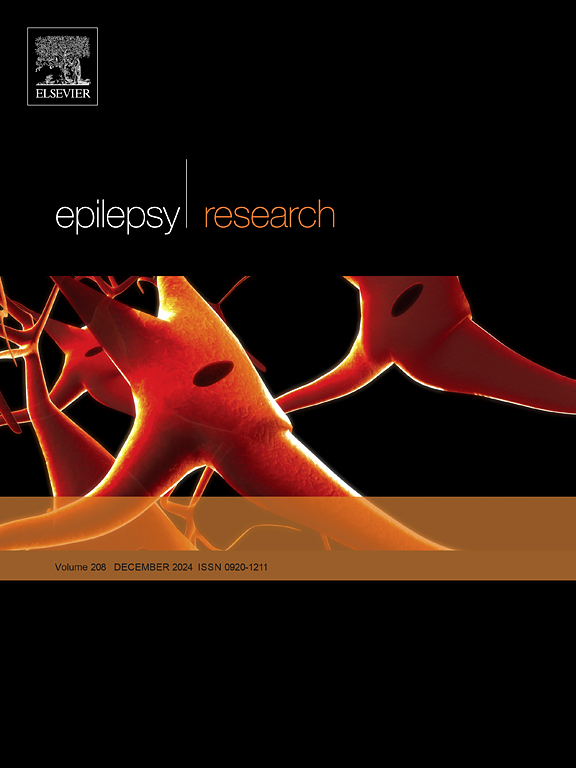Demographic and regional trends in status epilepticus-related mortality among older adults in the United States (1999–2020): A nationwide retrospective analysis
IF 2
4区 医学
Q3 CLINICAL NEUROLOGY
引用次数: 0
Abstract
Background and aims
Because mortality data related to Status Epilepticus among the elderly in the United States are lacking, demographical and regional trends from 1999 to 2020 were analyzed.
Methods
We conducted a cross-sectional analysis of death certificates from the Center for Disease Control and Prevention Wide-Ranging Online Data for Epidemiologic Research (CDC-WONDER) database using crude and age-adjusted mortality rates (AAMR), followed by Jointpoint regression models yielding annual percentage changes (APCs) stratified to age, race/ethnicity, urban-rural classification, and region.
Results
It was observed that from 1999 to 2020, 17,883 deaths from status epilepticus among adults 65 and above were observed with a substantial decrease from 1999 to 2005 (APC: −4.6; 95 % CI: −8.1 to −0.9). This was then reversed with an increase till 2020 (APC:7.7; 95 % CI: 7–8.4). Moreover, it was observed that Black or African American mortality rates were significantly higher from 2007 to 2020 (APC of 7.99; 95 % CI, 7.03–8.96). Both Metropolitan 2006–2018 (APC: 8.21; 95 % CI, 7.37–9.05) and non-metropolitan areas from 2006 to 2020 (APC: 8.20; 95 % CI, 6.86–9.56) showed a rise in APC trends. The highest AAMRs occurred in South Carolina (AAMR: 97.5) followed by Kentucky (AAMR: 30.4) with the Southern region exhibiting the highest AAMR at 2.2.
Conclusion
The study reveals a significant increase in mortality rates from status epilepticus among the elderly, particularly within Black or African American communities and the Southern United States. These findings underscore the urgent need for targeted public health strategies to address and mitigate these growing disparities.
美国老年人癫痫状态相关死亡率的人口统计学和区域趋势(1999-2020):一项全国性的回顾性分析
背景与目的由于缺乏与美国老年人癫痫持续状态相关的死亡率数据,因此对1999年至2020年的人口和地区趋势进行了分析。方法我们使用粗死亡率和年龄调整死亡率(AAMR)对来自疾病控制和预防中心广泛的流行病学研究在线数据(CDC-WONDER)数据库的死亡证明进行了横断面分析,然后使用结合点回归模型得出按年龄、种族/民族、城乡分类和地区分层的年百分比变化(apc)。结果1999年至2020年,65岁及以上成人癫痫持续状态死亡17,883例,1999年至2005年大幅下降(APC: - 4.6;95 % CI:−8.1 ~−0.9)。这一趋势随后逆转,直到2020年仍在增长(APC:7.7;95 % ci: 7-8.4)。此外,据观察,2007年至2020年,黑人或非裔美国人死亡率明显较高(APC为7.99;95 % ci, 7.03-8.96)。2006-2018年大都会(APC: 8.21;95 % CI, 7.37-9.05)和非都市地区(APC: 8.20;95 % CI, 6.86-9.56)显示APC呈上升趋势。AAMR最高的是南卡罗来纳州(AAMR为97.5),其次是肯塔基州(AAMR为30.4),南部地区AAMR最高,为2.2。结论:该研究揭示了老年人癫痫持续状态死亡率的显著增加,特别是在黑人或非洲裔美国人社区和美国南部。这些调查结果强调,迫切需要制定有针对性的公共卫生战略,以解决和减轻这些日益扩大的差距。
本文章由计算机程序翻译,如有差异,请以英文原文为准。
求助全文
约1分钟内获得全文
求助全文
来源期刊

Epilepsy Research
医学-临床神经学
CiteScore
0.10
自引率
4.50%
发文量
143
审稿时长
62 days
期刊介绍:
Epilepsy Research provides for publication of high quality articles in both basic and clinical epilepsy research, with a special emphasis on translational research that ultimately relates to epilepsy as a human condition. The journal is intended to provide a forum for reporting the best and most rigorous epilepsy research from all disciplines ranging from biophysics and molecular biology to epidemiological and psychosocial research. As such the journal will publish original papers relevant to epilepsy from any scientific discipline and also studies of a multidisciplinary nature. Clinical and experimental research papers adopting fresh conceptual approaches to the study of epilepsy and its treatment are encouraged. The overriding criteria for publication are novelty, significant clinical or experimental relevance, and interest to a multidisciplinary audience in the broad arena of epilepsy. Review articles focused on any topic of epilepsy research will also be considered, but only if they present an exceptionally clear synthesis of current knowledge and future directions of a research area, based on a critical assessment of the available data or on hypotheses that are likely to stimulate more critical thinking and further advances in an area of epilepsy research.
 求助内容:
求助内容: 应助结果提醒方式:
应助结果提醒方式:


